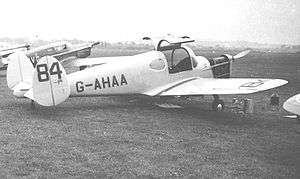Miles Mercury
The Miles M.28 Mercury was a British aircraft designed to meet the need for a training and communications plane during the Second World War. It was a single-engined monoplane of wooden construction with a twin tail and a tailwheel undercarriage with retractable main units.
| M.28 Mercury | |
|---|---|
 | |
| The Miles M.28 Mercury 6 at Wolverhampton (Pendeford) Airport in May 1951. This aircraft later went to Denmark. | |
| Role | Trainer & communications aircraft |
| Manufacturer | Phillips & Powis |
| Designer | Ray Bournon |
| First flight | 11 July 1941 |
| Status | one remains operational |
| Primary user | private pilot owners |
| Number built | six |
| Variants | Miles Messenger |
Development
Originally, the M.28 had been planned as a replacement for the Whitney Straight and Monarch, but this was shelved when war broke out.
In 1941, the project was revived in response to a requirement for a training and communications aircraft. The design was produced as a private venture by Ray Bournon using Miles' normal wooden construction. The resulting machine introduced several features not found on trainers: retractable undercarriage and trailing edge flaps amongst others. In the communications role, the M.28 had four seats and a range of 500 miles (800 km).
The prototype first flew on 11 July 1941 [1] and proved easy to fly, with light controls and a short landing run. Owing to Miles' heavy commitment to war-production, however, only six aircraft were built, of slightly varying specifications, the last being the Mercury 6 which first flew in early 1946.[2] Examples of the type were operated in the United Kingdom, Denmark, Germany, Switzerland and Australia.
Variants
- M.28 Mark I: First prototype – Two seat trainer, powered by 130 hp (97 kW) de Havilland Gipsy Major I engine.[3]
- M.28 Mark II: Three seat trainer (with dual controls) powered by 140 hp (100 kW) de Havilland Gipsy Major IIA. One built 1942. Re-engined with 140 hp Blackburn Cirrus Major II and then with a 150 hp (110 kW) Cirrus Major III post-war.[4]
- M.28 Mark III: Three seat trainer with triple controls for two students and one instructor, powered by 150 hp Cirrus Major 3 and with revised wing section. One built (PW937).[5][6]
- M.28 Mark IV: Four seat communications aircraft powered by 145 hp (108 kW) Gipsy Major IIA. One built 1944.[4]
- M.28 Mark V: Post-war four-seater powered by Cirrus Major III. Square rear windows. One built 1947.[7]
- M.28 Mark VI: Post war four-seater powered by Cirrus Major III. Round rear windows. One built 1946.[7]
Specifications (M.28)
Data from Miles Aircraft since 1925[8]
General characteristics
- Crew: one
- Capacity: 2 or 3 passengers
- Length: 24 ft 0 in (7.32 m)
- Wingspan: 30 ft 8 in (9.35 m)
- Height: 8 ft 4 in (2.54 m)
- Wing area: 162 sq ft (15.1 m2)
- Aspect ratio: 5.8
- Airfoil: root: NACA 23018; tip: NACA 2412
- Empty weight: 1,658 lb (752 kg)
- Gross weight: 2,500 lb (1,134 kg)
- Fuel capacity: 24 imp gal (29 US gal; 110 l) fuel ; 2.5 imp gal (3.0 US gal; 11 l)
- Powerplant: 1 × Blackburn Cirrus Major III 4-cylinder air-cooled inverted in-line piston engine, 150 hp (110 kW)
- Propellers: 2-bladed fixed-pitch propeller
Performance
- Maximum speed: 159 mph (256 km/h, 138 kn)
- Cruise speed: 152 mph (245 km/h, 132 kn)
- Stall speed: 46 mph (74 km/h, 40 kn) flaps down
- 60 mph (52 kn; 97 km/h) flaps up
- Range: 408 mi (657 km, 355 nmi)
- Endurance: 2 hours 45 minutes
- Rate of climb: 840 ft/min (4.3 m/s)
- Time to altitude: 10,000 ft (3,048 m) in 14 minutes
- Wing loading: 15.4 lb/sq ft (75 kg/m2)
- Take-off run: 600 ft (183 m)
- Take-off distance to 50 ft (15 m): 1,344 ft (410 m)
- Landing run: 495 ft (151 m)
- Landing distance from 50 ft (15 m): 942 ft (287 m)
References
| Wikimedia Commons has media related to Miles Mercury. |
Notes
- Mondey 2002, p. 172.
- Jackson, 1974, p.271
- Jerram Aeroplane Monthly September 1986, p. 474.
- Jerram Aeroplane Monthly September 1986, pp. 475–476.
- Jerram Aeroplane Monthly September 1986, p. 475.
- Mason 2010, p. 251.
- Jerram Aeroplane Monthly September 1986, p. 476.
- Brown, Don L. (1970). Miles Aircraft since 1925 (1st ed.). London: Putnam & Company Ltd. pp. 163-172. ISBN 0-370-00127-3.
Bibliography
- Amos, Peter. and Brown, Don Lambert. Miles Aircraft Since 1925, Volume 1. London: Putnam Aeronautical, 2000. ISBN 0-85177-787-2.
- Brown, Don Lambert. Miles Aircraft Since 1925. London: Putnam & Company Ltd., 1970. ISBN 0-370-00127-3.
- Jackson, A.J. British Civil Aircraft since 1919 - Volume 3. 1974. Putnam & Company Ltd. ISBN 0-370-10014-X.
- Jerram, Mike. "For Business And Pleasure—No. 3", Aeroplane Monthly, Vol. 14, No. 9, September 1986. pp. 474–477. ISSN 0143-7240.
- Mason, Tim. The Secret Years: Flight Testing at Boscombe Down, 1939-1945. Crowborough, UK: Hikoki Publications, 2010. ISBN 978-1-9021-0914-5.
- Mondey, David. The Hamlyn Concise Guide to British Aircraft of World War II. London: Chancellor Press, 2002. ISBN 1-85152-668-4.